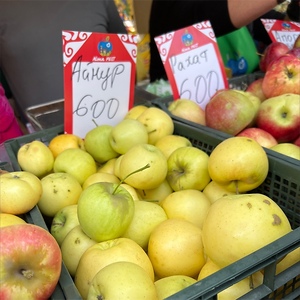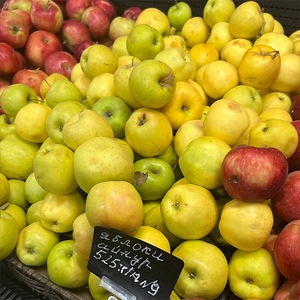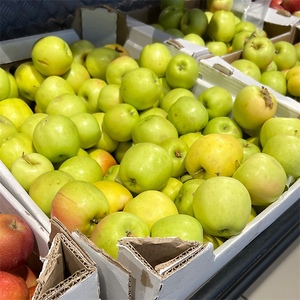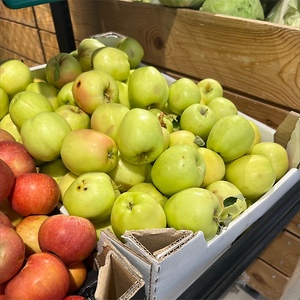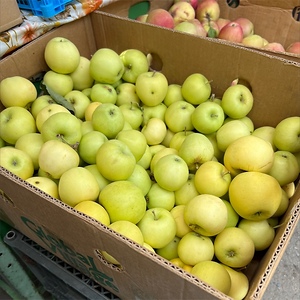


Ainur Apples
Estimated Inventory, lb : 0
Description/Taste
Ainur apples are moderately-sized fruits with a round to oval shape. The apples have a somewhat uniform appearance with shallow, flattened shoulders connected to a fibrous green-brown stem. The skin is smooth, thin, and glossy with a golden yellow base. The surface is also covered in a few, faint lenticels and is sometimes blushed with light pink and red hues. Underneath the skin, the flesh is pale yellow to ivory, fine-grained, and aqueous with a dense, tender, and crisp consistency. The flesh also encases a small, central fibrous core filled with dark brown, oval seeds. Ainur apples are aromatic with a fruity scent and have a balanced, sweet, tart, and tangy flavor.
Seasons/Availability
Ainur apples are harvested in the fall through winter in Central Asia. When properly stored, the variety can be kept through the late spring.
Current Facts
Ainur apples, botanically classified as Malus domestica, are a late-season variety belonging to the Rosaceae family. The name Ainur translates from Kazakh to mean “moonlight,” and the variety was created in Kazakhstan as an improved cultivar in the late 20th century. Ainur apples are highly favored among growers and home gardeners in Central Asia for their increased disease resistance, weather tolerance, adaptability, and prolonged storage capabilities. The variety is also highly productive, yielding over 25 kilograms of fruit from a single tree. Internationally, Ainur apples have won many competitions, certificates, and awards for its balanced, sweet and sour flavor.
Nutritional Value
Ainur apples are an excellent source of vitamin C, an antioxidant that can strengthen the immune system, reduce inflammation, and boost collagen production within the skin. The fruits also contain potassium to regulate fluid levels in the body, fiber to stimulate digestion, and vitamin K to assist with faster wound healing.
Applications
Ainur apples are best suited for raw applications as their sweet-tart flavor and juicy flesh is showcased when consumed fresh, out-of-hand. The apples can be sliced and served with cheeses, dips, or spreads, chopped and tossed into green and fruit salads, or cut and stirred into yogurt and granola. The flesh can also be pressed into juice, blended into smoothies, or used as an edible garnish. In addition to fresh preparations, Ainur apples can be cooked into applesauce or simmered in jams, jellies, and preserves. They can also be baked as a sweet dessert or used as an ingredient in muffins, bread, cakes, crumbles, and pancakes. Ainur apples pair well with spices such as cloves, cinnamon, and nutmeg, vanilla, brown sugar, and nuts such as walnuts, pecans, and almonds. Whole, unwashed Ainur apples will keep for 8 to 9 months when placed in cold storage.
Ethnic/Cultural Info
Ainur apples were one of forty apple varieties featured at Azerbaijan’s Alma Bayrami, translating to apple festival. The annual event was established in the fall of 2012 and was created to celebrate the bountiful harvest of autumn vegetables found locally in the city of Guba, the country’s largest fruit-producing region. During the festival, large sculptures made from apples were prominently displayed in between booths with vendors selling baked apple goods, drinks, and main dishes. There were also networking events where growers could meet to discuss apple cultivation. Beyond discussions and purchased goods, the festival's most popular events included live concerts, performers, cooking competitions, and a contest to find the largest apple.
Geography/History
Ainur apples were developed at the Kazakh Research Institute of Fruit and Viticulture in Almaty, Kazakhstan, from 1972 to 1981. The variety was created to be an improved cultivar, crossed from the golden delicious and aport apple, and was bred by scientists M.B. Caft, A.D. Vinovets, and L.V. Ostarkova. Ainur apples were approved for state testing in 1989, and once released to local growers, the cultivar became a preferred variety for cultivation in Kazakhstan. Ainur apples also increased in popularity in neighboring countries, and today, the variety is grown in Kazakhstan, Kyrgyzstan, Belarus, Azerbaijan, Siberia, and Central Russia.
Recipe Ideas
Recipes that include Ainur Apples. One



